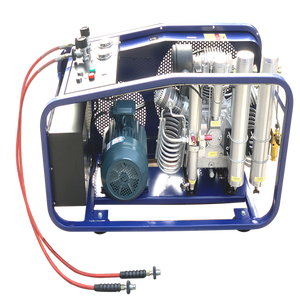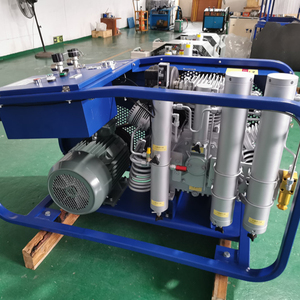
All categories
Featured selections
Trade Assurance
Buyer Central
Help Center
Get the app
Become a supplier

(10492 products available)






















A lab compressor is a device that increases the pressure of a gas by decreasing its volume. It is used in laboratories to provide gas at a pressure level that is higher than atmospheric. There are several types of lab compressors, including;
Piston air compressor:
This is the most common type of lab air compressor. It uses pistons driven by a crankshaft to deliver high-pressure air. Multiple cylinders can be used to produce higher pressures and flow rates. Piston air compressors are further divided into:
Single-stage compressors: These compressors draw in air and compress it to the desired pressure in a single cylinder. They are suitable for applications that require low to medium pressure. They are also simple and easy to maintain.
Multi-stage compressors: These compressors have two or more cylinders that compress the air in stages. They are ideal for applications that require high pressure and have a higher efficiency.
Rotary compressor:
These are widely used in modern laboratories due to their efficiency and reliability. Instead of pistons, they use rotating elements like rollers or vanes to compress the air. Rotary compressors are further divided into:
Rotary screw compressors: These compressors have two screws that rotate and trap the air in between. They progressively reduce the volume of the air and compress it. They are suitable for applications that have a continuous demand for compressed air.
Rotary Vane Compressors: These compressors have vanes that slide in and out of a rotor. The vanes trap the air in the slots and compress it as the rotor turns. They are suitable for applications that require low to medium pressure, high flow rates, and relatively quiet operations.
Diaphragm compressor:
They are also known as membrane compressors. They use a diaphragm to separate the compressed gas from the lubrication and drive components. This eliminates the contamination risk from oil or other lubricants. They are ideal for applications that require high purity, such as in pharmaceutical and chemical labs.
Scroll compressor:
These are lab air compressors that are used for compressing refrigerants in cooling systems. They have two interleaved scrolls that compress the refrigerant in an orbital motion. They are suitable for applications that require low noise levels and high reliability.
Screw compressor:
These are lab compressors that use two rotors that resemble screws. The rotors trap the air between them and compress it as they turn. They are suitable for applications that require high flow rates and continuous operation.
Every piece of equipment in a laboratory has specifications that guide its use and maintenance. Here are the specifications for lab compressors:
Size
Laboratory air compressors come in different sizes. There is no standard size for a compressor. The size of the compressor will be determined by the laboratory activities it is intended for. A compressor for a laboratory with high activities such as a medical laboratory will be bigger than a compressor for a school or research laboratory.
Noise Level
Noise level is an important consideration when choosing a compressor for a laboratory. There are set standards for noise levels for laboratory equipment. The noise level of the compressor should comply with the laboratory noise level standards.
Power Supply
Lab compressors are designed to work with the power supply available in laboratories. They are designed to operate on both single-phase and three-phase power supply.
Cooling
Compressors have varying cooling methods. Some have air cooling while others have water cooling. The cooling method of the compressor affects its efficiency. Compressors with water cooling are more efficient than those with air cooling.
Pressure Range
Laboratory compressors have varying pressure ranges. The pressure range determines the application of the compressor. Compressors with higher pressure ranges are suitable for laboratory activities that require high pressure.
Oil-free
Oil-free compressors are void of contaminants in the compressed air. The compressed air from an oil-free lab compressor is clean and dry. This is an important feature for laboratories that require clean air for their processes.
Portability
Some lab compressors are portable while others are not. Compressors that are not portable have a big size and weight due to their construction. Portable compressors are useful in laboratories that require mobile compressed air.
It is important to maintain a lab compressor to ensure a constant, reliable, and safe source of compressed air. The following are important considerations when maintaining a lab compressor:
There are several factors to consider when buying a lab air compressor, including the following:
Noise Level
It's no secret that compressors are loud. If the compressor is too loud, it can interfere with the laboratory's work environment. Fortunately, there are ways to address the noise issue. For instance, one can buy a compressor that operates at a lower noise level. Alternatively, one can purchase a compressor sound enclosure to minimize the noise.
Power Supply
Lab air compressors are available in various power supply options. It is important to choose a compressor with a power supply that corresponds to the laboratory's electrical system. The options available include 110 to 120 volts single-phase, 220 to 240 volts single-phase, and 380 to 415 volts three-phase.
Application Requirements
Before choosing any lab-grade air compressor, users must understand the application requirements. This includes the required pressure, the flow rate needed, and the quality of the air required. The specific application determines the type of compressor to choose.
Portability
In some laboratories, there is a need for portable air compressors. If portability is a requirement, then a lightweight and portable design should be chosen. The portable compressors have rechargeable batteries for on-the-go applications.
Size and Footprint
Lab-grade air compressors are available in different sizes. It is essential to choose a compressor with a size that corresponds to the laboratory's available space. The size and footprint of a compressor will be determined by the design and model of the compressor.
Quality and Purity of Compressed Air
In laboratories, there are cases where the quality and purity of compressed air is critical. This is because the compressed air is used for sensitive applications. In such scenarios, the quality and purity of the compressed air must be free from oils, particulates, and moisture. To achieve this, a lab air compressor with built-in filtration and drying systems should be chosen. The in-built systems will ensure that the compressed air is clean and suitable for critical applications.
Replacing a lab air compressor can be a complex task, but some basic steps should be followed to ensure a smooth transition. Here are some steps to consider:
Q1: What is a lab compressor?
A1: A lab compressor is a device used in laboratories to provide compressed air or gas for various applications, such as powering instruments, driving pneumatic devices, and performing lab processes requiring controlled gas flow.
Q2: What are the types of lab compressors?
A2: There are several types of lab compressors, including piston (reciprocating) compressors, rotary compressors, diaphragm compressors, and screw compressors. Each type is suitable for different applications based on the required compression level, flow rate, and gas purity requirements.
Q3: What are the applications of lab compressors?
A3: Lab compressors are used in various applications, including gas chromatography, sample preparation, pneumatic controls, and other processes requiring precise gas management and flow control.
Q4: Is a lab compressor a gas compressor?
A4: Yes, a lab compressor is a gas compressor that compresses gases (air) to lower volumes and higher pressures for various laboratory applications.
Q5: Do lab compressors require maintenance?
A5: Yes, regular maintenance is required to ensure optimal performance, reliability, and safety. This includes routine checks, filter replacements, oil changes (for oil-lubricated compressors), and inspection of wear parts.